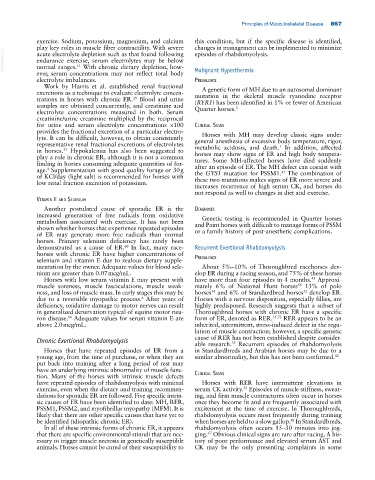Page 901 - Adams and Stashak's Lameness in Horses, 7th Edition
P. 901
Principles of Musculoskeletal Disease 867
exercise. Sodium, potassium, magnesium, and calcium this condition, but if the specific disease is identified,
play key roles in muscle fiber contractility. With severe changes in management can be implemented to minimize
VetBooks.ir endurance exercise, serum electrolytes may be below
episodes of rhabdomyolysis.
acute electrolyte depletion such as that found following
normal ranges. With chronic dietary depletion, how
11
ever, serum concentrations may not reflect total body Malignant Hyperthermia
electrolyte imbalances. PrevalenCe
Work by Harris et al. established renal fractional
excretions as a technique to evaluate electrolyte concen A genetic form of MH due to an autosomal dominant
28
trations in horses with chronic ER. Blood and urine mutation in the skeletal muscle ryanodine receptor
(RYR1) has been identified in 1% or fewer of American
samples are obtained concurrently, and creatinine and 2
electrolyte concentrations measured in both. Serum Quarter horses.
creatinine/urine creatinine multiplied by the reciprocal
for urine and serum electrolyte concentrations ×100 ClInICal sIgns
provides the fractional excretion of a particular electro
Horses with MH may develop classic signs under
lyte. It can be difficult, however, to obtain consistently general anesthesia of excessive body temperature, rigor,
representative renal fractional excretions of electrolytes 1
53
in horses. Hypokalemia has also been suggested to metabolic acidosis, and death. In addition, affected
horses may show signs of ER and high body tempera
play a role in chronic ER, although it is not a common
finding in horses consuming adequate quantities of for tures. Some MH‐affected horses have died suddenly
after an episode of ER. The MH defect can coexist with
age. Supplementation with good quality forage or 30 g 45
4
of KCl/day (light salt) is recommended for horses with the GYS1 mutation for PSSM1. The combination of
these two mutations makes signs of ER more severe and
low renal fraction excretion of potassium.
increases recurrence of high serum CK, and horses do
not respond as well to changes in diet and exercise.
vItamIn e and selenIum
Another postulated cause of sporadic ER is the dIagnosIs
increased generation of free radicals from oxidative Genetic testing is recommended in Quarter horses
metabolism associated with exercise. It has not been
shown whether horses that experience repeated episodes and Paint horses with difficult to manage forms of PSSM
or a family history of post‐anesthetic complications.
of ER may generate more free radicals than normal
horses. Primary selenium deficiency has rarely been
demonstrated as a cause of ER. In fact, many race Recurrent Exertional Rhabdomyolysis
60
horses with chronic ER have higher concentrations of
selenium and vitamin E due to zealous dietary supple PrevalenCe
mentation by the owner. Adequate values for blood sele About 5%–10% of Thoroughbred racehorses dev
nium are greater than 0.07 mcg/mL. elop ER during a racing season, and 75% of these horses
Horses with low serum vitamin E may present with have more than four episodes in 4 months. Approxi
41
muscle soreness, muscle fasciculations, muscle weak mately 6% of National Hunt horses 13% of polo
68
32
ness, and loss of muscle mass. In early stages this may be horses and 6% of Standardbred horses develop ER.
54
due to a reversible myopathic process. After years of Horses with a nervous disposition, especially fillies, are
6
deficiency, oxidative damage to motor nerves can result highly predisposed. Research suggests that a subset of
in generalized denervation typical of equine motor neu Thoroughbred horses with chronic ER have a specific
16
ron disease. Adequate values for serum vitamin E are form of ER, denoted as RER. 35,72 RER appears to be an
above 2.0 mcg/mL. inherited, intermittent, stress‐induced defect in the regu
lation of muscle contraction; however, a specific genetic
cause of RER has not been established despite consider
Chronic Exertional Rhabdomyolysis
able research. Recurrent episodes of rhabdomyolysis
35
Horses that have repeated episodes of ER from a in Standardbreds and Arabian horses may be due to a
young age, from the time of purchase, or when they are similar abnormality, but this has not been confirmed. 32
put back into training after a long period of rest may
have an underlying intrinsic abnormality of muscle func
tion. Many of the horses with intrinsic muscle defects ClInICal sIgns
have repeated episodes of rhabdomyolysis with minimal Horses with RER have intermittent elevations in
exercise, even when the dietary and training recommen serum CK activity. Episodes of muscle stiffness, sweat
55
dations for sporadic ER are followed. Five specific intrin ing, and firm muscle contractures often occur in horses
sic causes of ER have been identified to date: MH, RER, once they become fit and are frequently associated with
PSSM1, PSSM2, and myofibrillar myopathy (MFM). It is excitement at the time of exercise. In Thoroughbreds,
likely that there are other specific causes that have yet to rhabdomyolysis occurs most frequently during training
be identified (idiopathic chronic ER). when horses are held to a slow gallop. In Standardbreds,
41
In all of these intrinsic forms of chronic ER, it appears rhabdomyolysis often occurs 15–30 minutes into jog
that there are specific environmental stimuli that are nec ging. Obvious clinical signs are rare after racing. A his
67
essary to trigger muscle necrosis in genetically susceptible tory of poor performance and elevated serum AST and
animals. Horses cannot be cured of their susceptibility to CK may be the only presenting complaints in some

